NURS4009 Teaching Plan: Hand, Foot, and Mouth Disease
VerifiedAdded on 2022/09/29
|9
|2220
|22
Report
AI Summary
This report presents a detailed teaching plan designed for parents regarding the management of hand, foot, and mouth disease (HFMD) in children, specifically those entering kindergarten. The plan, developed by a student, focuses on a parent in Bentley, Western Australia, whose child is about to start kindergarten. It covers essential aspects of the disease, including symptoms, causes, risk factors, and preventive measures. The teaching plan incorporates experiential learning and Roy Adaptation Model to enhance understanding and practical application. The plan outlines learning context, need evidence, learner type, aims, outcomes, teaching strategies and methods, anticipated strengths, limitations, and an evaluation plan. The primary goal is to equip parents with the knowledge and skills to identify, prevent, and manage HFMD, ensuring the health and well-being of their children. The report emphasizes the importance of early detection, precautionary measures, and clinical interventions, providing a comprehensive guide for parents. The evaluation plan includes self-reflection, goal setting, and feedback to assess the effectiveness of the teaching and learning process.
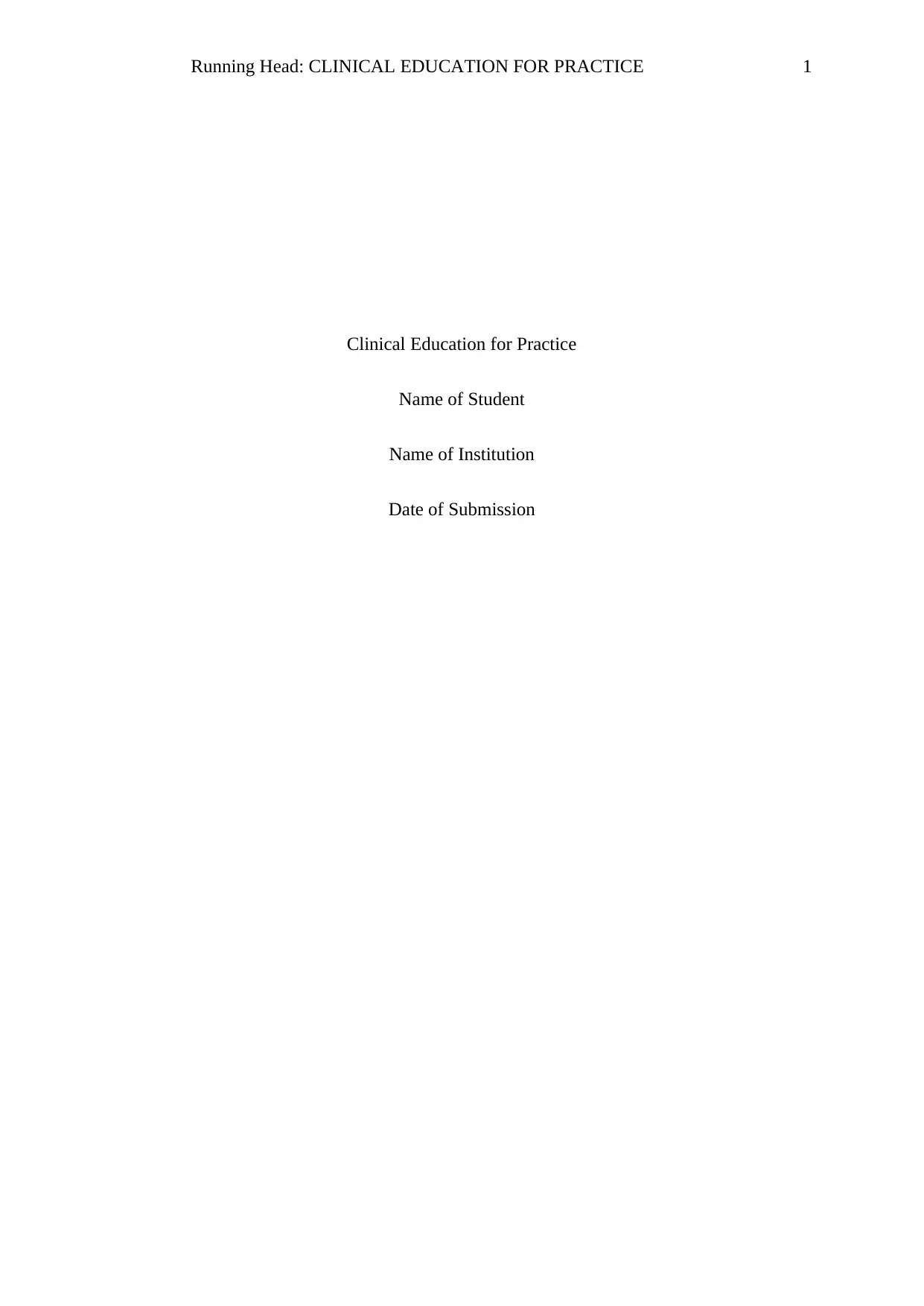
Running Head: CLINICAL EDUCATION FOR PRACTICE 1
Clinical Education for Practice
Name of Student
Name of Institution
Date of Submission
Clinical Education for Practice
Name of Student
Name of Institution
Date of Submission
Paraphrase This Document
Need a fresh take? Get an instant paraphrase of this document with our AI Paraphraser
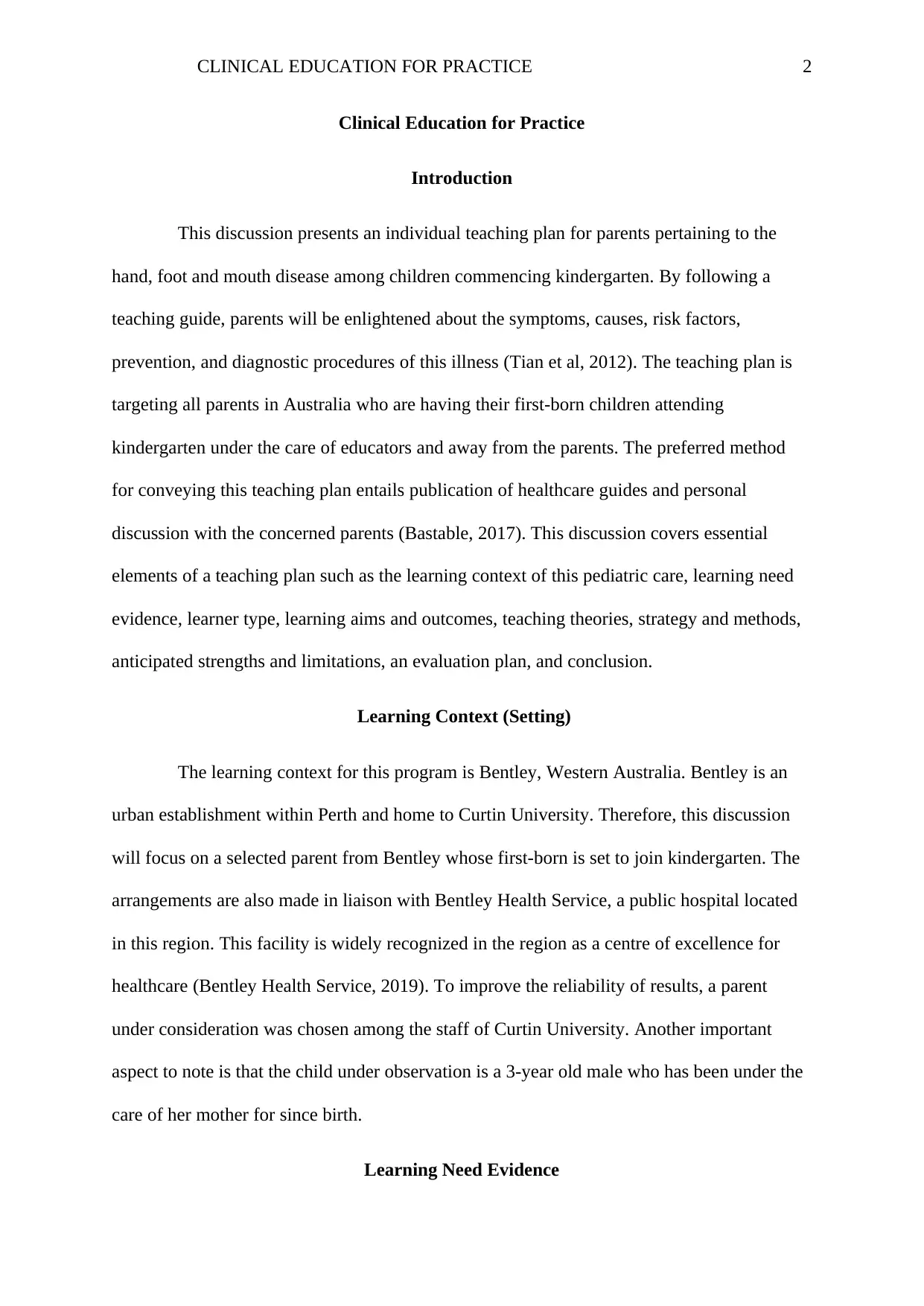
CLINICAL EDUCATION FOR PRACTICE 2
Clinical Education for Practice
Introduction
This discussion presents an individual teaching plan for parents pertaining to the
hand, foot and mouth disease among children commencing kindergarten. By following a
teaching guide, parents will be enlightened about the symptoms, causes, risk factors,
prevention, and diagnostic procedures of this illness (Tian et al, 2012). The teaching plan is
targeting all parents in Australia who are having their first-born children attending
kindergarten under the care of educators and away from the parents. The preferred method
for conveying this teaching plan entails publication of healthcare guides and personal
discussion with the concerned parents (Bastable, 2017). This discussion covers essential
elements of a teaching plan such as the learning context of this pediatric care, learning need
evidence, learner type, learning aims and outcomes, teaching theories, strategy and methods,
anticipated strengths and limitations, an evaluation plan, and conclusion.
Learning Context (Setting)
The learning context for this program is Bentley, Western Australia. Bentley is an
urban establishment within Perth and home to Curtin University. Therefore, this discussion
will focus on a selected parent from Bentley whose first-born is set to join kindergarten. The
arrangements are also made in liaison with Bentley Health Service, a public hospital located
in this region. This facility is widely recognized in the region as a centre of excellence for
healthcare (Bentley Health Service, 2019). To improve the reliability of results, a parent
under consideration was chosen among the staff of Curtin University. Another important
aspect to note is that the child under observation is a 3-year old male who has been under the
care of her mother for since birth.
Learning Need Evidence
Clinical Education for Practice
Introduction
This discussion presents an individual teaching plan for parents pertaining to the
hand, foot and mouth disease among children commencing kindergarten. By following a
teaching guide, parents will be enlightened about the symptoms, causes, risk factors,
prevention, and diagnostic procedures of this illness (Tian et al, 2012). The teaching plan is
targeting all parents in Australia who are having their first-born children attending
kindergarten under the care of educators and away from the parents. The preferred method
for conveying this teaching plan entails publication of healthcare guides and personal
discussion with the concerned parents (Bastable, 2017). This discussion covers essential
elements of a teaching plan such as the learning context of this pediatric care, learning need
evidence, learner type, learning aims and outcomes, teaching theories, strategy and methods,
anticipated strengths and limitations, an evaluation plan, and conclusion.
Learning Context (Setting)
The learning context for this program is Bentley, Western Australia. Bentley is an
urban establishment within Perth and home to Curtin University. Therefore, this discussion
will focus on a selected parent from Bentley whose first-born is set to join kindergarten. The
arrangements are also made in liaison with Bentley Health Service, a public hospital located
in this region. This facility is widely recognized in the region as a centre of excellence for
healthcare (Bentley Health Service, 2019). To improve the reliability of results, a parent
under consideration was chosen among the staff of Curtin University. Another important
aspect to note is that the child under observation is a 3-year old male who has been under the
care of her mother for since birth.
Learning Need Evidence
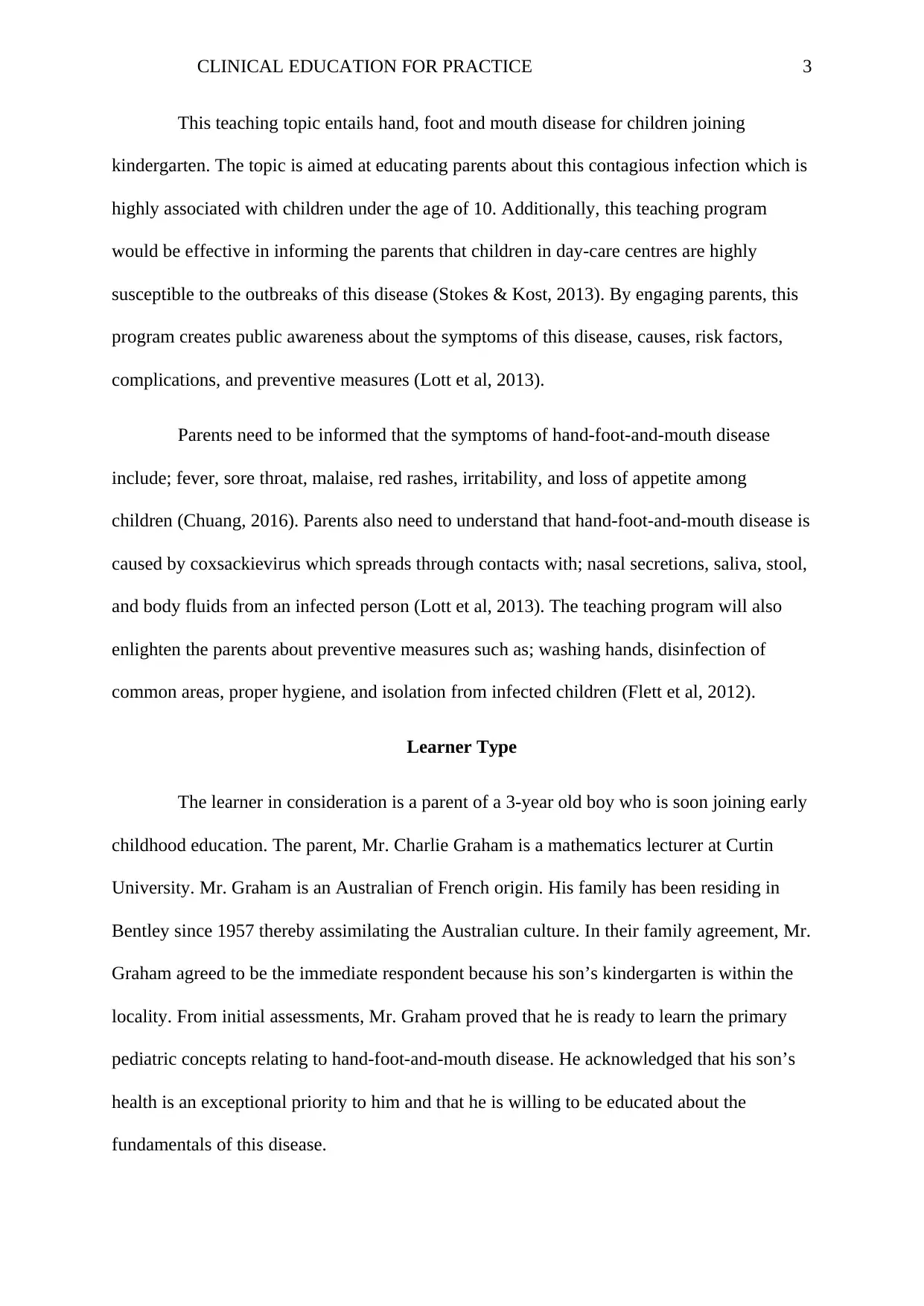
CLINICAL EDUCATION FOR PRACTICE 3
This teaching topic entails hand, foot and mouth disease for children joining
kindergarten. The topic is aimed at educating parents about this contagious infection which is
highly associated with children under the age of 10. Additionally, this teaching program
would be effective in informing the parents that children in day-care centres are highly
susceptible to the outbreaks of this disease (Stokes & Kost, 2013). By engaging parents, this
program creates public awareness about the symptoms of this disease, causes, risk factors,
complications, and preventive measures (Lott et al, 2013).
Parents need to be informed that the symptoms of hand-foot-and-mouth disease
include; fever, sore throat, malaise, red rashes, irritability, and loss of appetite among
children (Chuang, 2016). Parents also need to understand that hand-foot-and-mouth disease is
caused by coxsackievirus which spreads through contacts with; nasal secretions, saliva, stool,
and body fluids from an infected person (Lott et al, 2013). The teaching program will also
enlighten the parents about preventive measures such as; washing hands, disinfection of
common areas, proper hygiene, and isolation from infected children (Flett et al, 2012).
Learner Type
The learner in consideration is a parent of a 3-year old boy who is soon joining early
childhood education. The parent, Mr. Charlie Graham is a mathematics lecturer at Curtin
University. Mr. Graham is an Australian of French origin. His family has been residing in
Bentley since 1957 thereby assimilating the Australian culture. In their family agreement, Mr.
Graham agreed to be the immediate respondent because his son’s kindergarten is within the
locality. From initial assessments, Mr. Graham proved that he is ready to learn the primary
pediatric concepts relating to hand-foot-and-mouth disease. He acknowledged that his son’s
health is an exceptional priority to him and that he is willing to be educated about the
fundamentals of this disease.
This teaching topic entails hand, foot and mouth disease for children joining
kindergarten. The topic is aimed at educating parents about this contagious infection which is
highly associated with children under the age of 10. Additionally, this teaching program
would be effective in informing the parents that children in day-care centres are highly
susceptible to the outbreaks of this disease (Stokes & Kost, 2013). By engaging parents, this
program creates public awareness about the symptoms of this disease, causes, risk factors,
complications, and preventive measures (Lott et al, 2013).
Parents need to be informed that the symptoms of hand-foot-and-mouth disease
include; fever, sore throat, malaise, red rashes, irritability, and loss of appetite among
children (Chuang, 2016). Parents also need to understand that hand-foot-and-mouth disease is
caused by coxsackievirus which spreads through contacts with; nasal secretions, saliva, stool,
and body fluids from an infected person (Lott et al, 2013). The teaching program will also
enlighten the parents about preventive measures such as; washing hands, disinfection of
common areas, proper hygiene, and isolation from infected children (Flett et al, 2012).
Learner Type
The learner in consideration is a parent of a 3-year old boy who is soon joining early
childhood education. The parent, Mr. Charlie Graham is a mathematics lecturer at Curtin
University. Mr. Graham is an Australian of French origin. His family has been residing in
Bentley since 1957 thereby assimilating the Australian culture. In their family agreement, Mr.
Graham agreed to be the immediate respondent because his son’s kindergarten is within the
locality. From initial assessments, Mr. Graham proved that he is ready to learn the primary
pediatric concepts relating to hand-foot-and-mouth disease. He acknowledged that his son’s
health is an exceptional priority to him and that he is willing to be educated about the
fundamentals of this disease.
⊘ This is a preview!⊘
Do you want full access?
Subscribe today to unlock all pages.

Trusted by 1+ million students worldwide
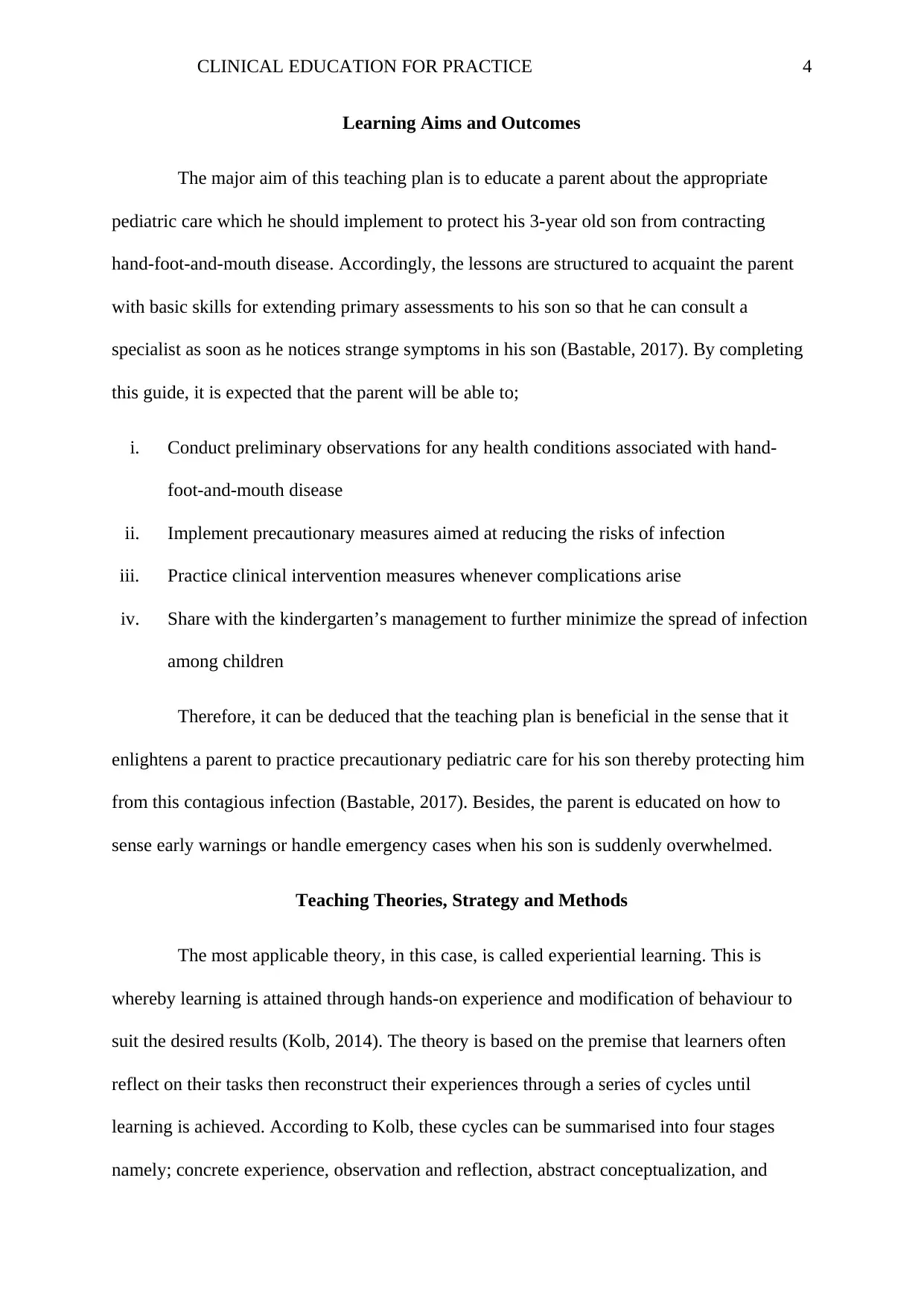
CLINICAL EDUCATION FOR PRACTICE 4
Learning Aims and Outcomes
The major aim of this teaching plan is to educate a parent about the appropriate
pediatric care which he should implement to protect his 3-year old son from contracting
hand-foot-and-mouth disease. Accordingly, the lessons are structured to acquaint the parent
with basic skills for extending primary assessments to his son so that he can consult a
specialist as soon as he notices strange symptoms in his son (Bastable, 2017). By completing
this guide, it is expected that the parent will be able to;
i. Conduct preliminary observations for any health conditions associated with hand-
foot-and-mouth disease
ii. Implement precautionary measures aimed at reducing the risks of infection
iii. Practice clinical intervention measures whenever complications arise
iv. Share with the kindergarten’s management to further minimize the spread of infection
among children
Therefore, it can be deduced that the teaching plan is beneficial in the sense that it
enlightens a parent to practice precautionary pediatric care for his son thereby protecting him
from this contagious infection (Bastable, 2017). Besides, the parent is educated on how to
sense early warnings or handle emergency cases when his son is suddenly overwhelmed.
Teaching Theories, Strategy and Methods
The most applicable theory, in this case, is called experiential learning. This is
whereby learning is attained through hands-on experience and modification of behaviour to
suit the desired results (Kolb, 2014). The theory is based on the premise that learners often
reflect on their tasks then reconstruct their experiences through a series of cycles until
learning is achieved. According to Kolb, these cycles can be summarised into four stages
namely; concrete experience, observation and reflection, abstract conceptualization, and
Learning Aims and Outcomes
The major aim of this teaching plan is to educate a parent about the appropriate
pediatric care which he should implement to protect his 3-year old son from contracting
hand-foot-and-mouth disease. Accordingly, the lessons are structured to acquaint the parent
with basic skills for extending primary assessments to his son so that he can consult a
specialist as soon as he notices strange symptoms in his son (Bastable, 2017). By completing
this guide, it is expected that the parent will be able to;
i. Conduct preliminary observations for any health conditions associated with hand-
foot-and-mouth disease
ii. Implement precautionary measures aimed at reducing the risks of infection
iii. Practice clinical intervention measures whenever complications arise
iv. Share with the kindergarten’s management to further minimize the spread of infection
among children
Therefore, it can be deduced that the teaching plan is beneficial in the sense that it
enlightens a parent to practice precautionary pediatric care for his son thereby protecting him
from this contagious infection (Bastable, 2017). Besides, the parent is educated on how to
sense early warnings or handle emergency cases when his son is suddenly overwhelmed.
Teaching Theories, Strategy and Methods
The most applicable theory, in this case, is called experiential learning. This is
whereby learning is attained through hands-on experience and modification of behaviour to
suit the desired results (Kolb, 2014). The theory is based on the premise that learners often
reflect on their tasks then reconstruct their experiences through a series of cycles until
learning is achieved. According to Kolb, these cycles can be summarised into four stages
namely; concrete experience, observation and reflection, abstract conceptualization, and
Paraphrase This Document
Need a fresh take? Get an instant paraphrase of this document with our AI Paraphraser
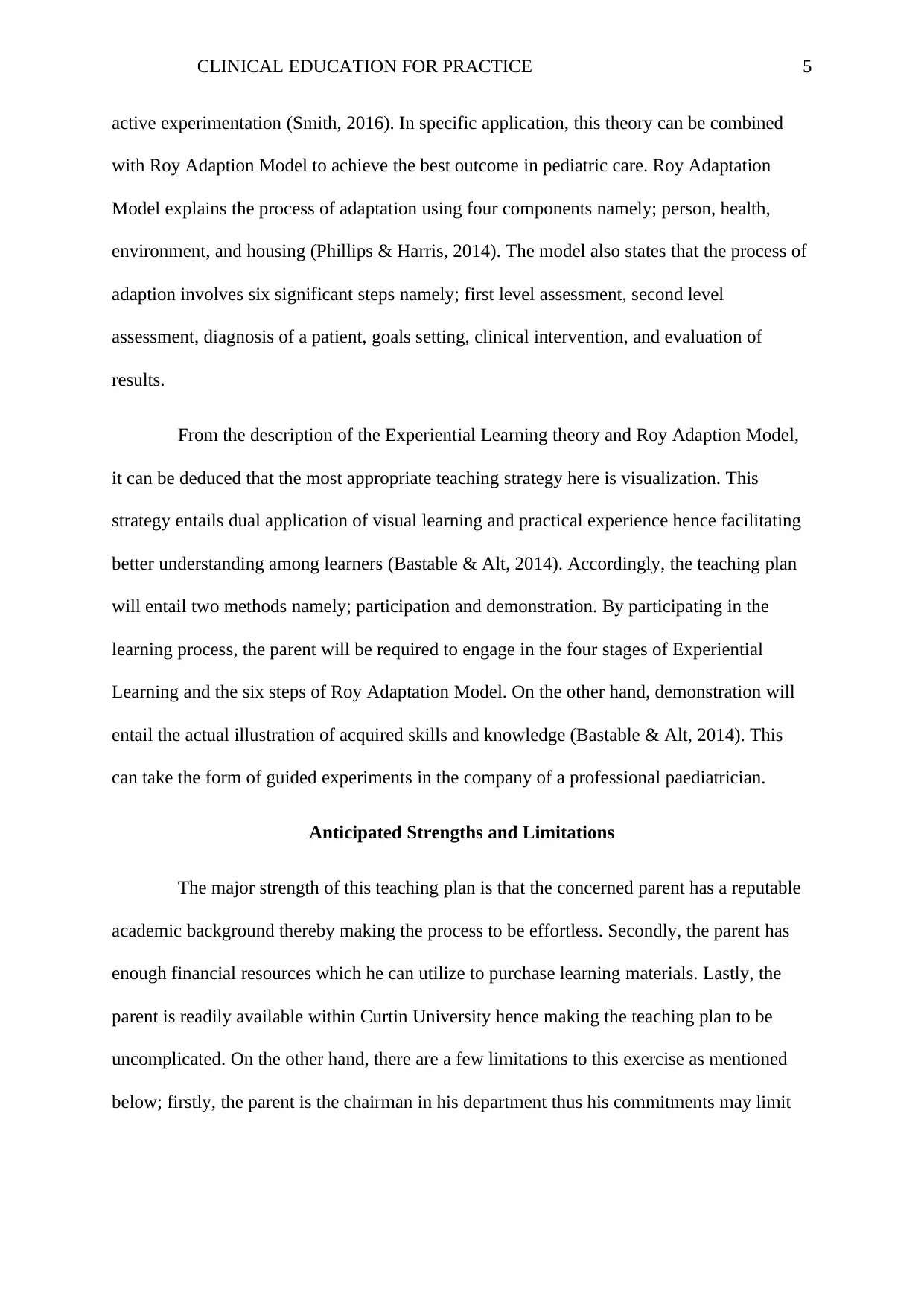
CLINICAL EDUCATION FOR PRACTICE 5
active experimentation (Smith, 2016). In specific application, this theory can be combined
with Roy Adaption Model to achieve the best outcome in pediatric care. Roy Adaptation
Model explains the process of adaptation using four components namely; person, health,
environment, and housing (Phillips & Harris, 2014). The model also states that the process of
adaption involves six significant steps namely; first level assessment, second level
assessment, diagnosis of a patient, goals setting, clinical intervention, and evaluation of
results.
From the description of the Experiential Learning theory and Roy Adaption Model,
it can be deduced that the most appropriate teaching strategy here is visualization. This
strategy entails dual application of visual learning and practical experience hence facilitating
better understanding among learners (Bastable & Alt, 2014). Accordingly, the teaching plan
will entail two methods namely; participation and demonstration. By participating in the
learning process, the parent will be required to engage in the four stages of Experiential
Learning and the six steps of Roy Adaptation Model. On the other hand, demonstration will
entail the actual illustration of acquired skills and knowledge (Bastable & Alt, 2014). This
can take the form of guided experiments in the company of a professional paediatrician.
Anticipated Strengths and Limitations
The major strength of this teaching plan is that the concerned parent has a reputable
academic background thereby making the process to be effortless. Secondly, the parent has
enough financial resources which he can utilize to purchase learning materials. Lastly, the
parent is readily available within Curtin University hence making the teaching plan to be
uncomplicated. On the other hand, there are a few limitations to this exercise as mentioned
below; firstly, the parent is the chairman in his department thus his commitments may limit
active experimentation (Smith, 2016). In specific application, this theory can be combined
with Roy Adaption Model to achieve the best outcome in pediatric care. Roy Adaptation
Model explains the process of adaptation using four components namely; person, health,
environment, and housing (Phillips & Harris, 2014). The model also states that the process of
adaption involves six significant steps namely; first level assessment, second level
assessment, diagnosis of a patient, goals setting, clinical intervention, and evaluation of
results.
From the description of the Experiential Learning theory and Roy Adaption Model,
it can be deduced that the most appropriate teaching strategy here is visualization. This
strategy entails dual application of visual learning and practical experience hence facilitating
better understanding among learners (Bastable & Alt, 2014). Accordingly, the teaching plan
will entail two methods namely; participation and demonstration. By participating in the
learning process, the parent will be required to engage in the four stages of Experiential
Learning and the six steps of Roy Adaptation Model. On the other hand, demonstration will
entail the actual illustration of acquired skills and knowledge (Bastable & Alt, 2014). This
can take the form of guided experiments in the company of a professional paediatrician.
Anticipated Strengths and Limitations
The major strength of this teaching plan is that the concerned parent has a reputable
academic background thereby making the process to be effortless. Secondly, the parent has
enough financial resources which he can utilize to purchase learning materials. Lastly, the
parent is readily available within Curtin University hence making the teaching plan to be
uncomplicated. On the other hand, there are a few limitations to this exercise as mentioned
below; firstly, the parent is the chairman in his department thus his commitments may limit
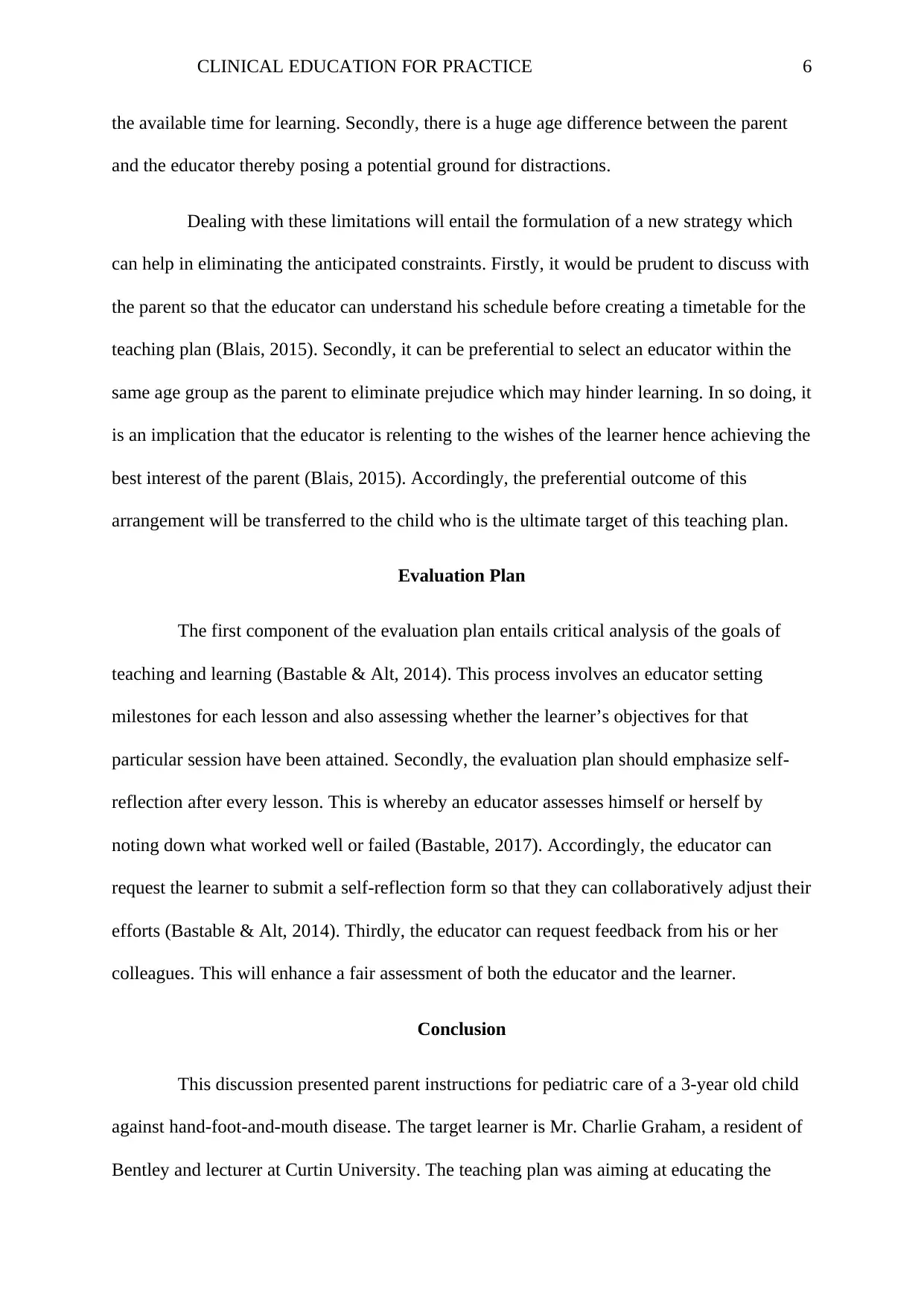
CLINICAL EDUCATION FOR PRACTICE 6
the available time for learning. Secondly, there is a huge age difference between the parent
and the educator thereby posing a potential ground for distractions.
Dealing with these limitations will entail the formulation of a new strategy which
can help in eliminating the anticipated constraints. Firstly, it would be prudent to discuss with
the parent so that the educator can understand his schedule before creating a timetable for the
teaching plan (Blais, 2015). Secondly, it can be preferential to select an educator within the
same age group as the parent to eliminate prejudice which may hinder learning. In so doing, it
is an implication that the educator is relenting to the wishes of the learner hence achieving the
best interest of the parent (Blais, 2015). Accordingly, the preferential outcome of this
arrangement will be transferred to the child who is the ultimate target of this teaching plan.
Evaluation Plan
The first component of the evaluation plan entails critical analysis of the goals of
teaching and learning (Bastable & Alt, 2014). This process involves an educator setting
milestones for each lesson and also assessing whether the learner’s objectives for that
particular session have been attained. Secondly, the evaluation plan should emphasize self-
reflection after every lesson. This is whereby an educator assesses himself or herself by
noting down what worked well or failed (Bastable, 2017). Accordingly, the educator can
request the learner to submit a self-reflection form so that they can collaboratively adjust their
efforts (Bastable & Alt, 2014). Thirdly, the educator can request feedback from his or her
colleagues. This will enhance a fair assessment of both the educator and the learner.
Conclusion
This discussion presented parent instructions for pediatric care of a 3-year old child
against hand-foot-and-mouth disease. The target learner is Mr. Charlie Graham, a resident of
Bentley and lecturer at Curtin University. The teaching plan was aiming at educating the
the available time for learning. Secondly, there is a huge age difference between the parent
and the educator thereby posing a potential ground for distractions.
Dealing with these limitations will entail the formulation of a new strategy which
can help in eliminating the anticipated constraints. Firstly, it would be prudent to discuss with
the parent so that the educator can understand his schedule before creating a timetable for the
teaching plan (Blais, 2015). Secondly, it can be preferential to select an educator within the
same age group as the parent to eliminate prejudice which may hinder learning. In so doing, it
is an implication that the educator is relenting to the wishes of the learner hence achieving the
best interest of the parent (Blais, 2015). Accordingly, the preferential outcome of this
arrangement will be transferred to the child who is the ultimate target of this teaching plan.
Evaluation Plan
The first component of the evaluation plan entails critical analysis of the goals of
teaching and learning (Bastable & Alt, 2014). This process involves an educator setting
milestones for each lesson and also assessing whether the learner’s objectives for that
particular session have been attained. Secondly, the evaluation plan should emphasize self-
reflection after every lesson. This is whereby an educator assesses himself or herself by
noting down what worked well or failed (Bastable, 2017). Accordingly, the educator can
request the learner to submit a self-reflection form so that they can collaboratively adjust their
efforts (Bastable & Alt, 2014). Thirdly, the educator can request feedback from his or her
colleagues. This will enhance a fair assessment of both the educator and the learner.
Conclusion
This discussion presented parent instructions for pediatric care of a 3-year old child
against hand-foot-and-mouth disease. The target learner is Mr. Charlie Graham, a resident of
Bentley and lecturer at Curtin University. The teaching plan was aiming at educating the
⊘ This is a preview!⊘
Do you want full access?
Subscribe today to unlock all pages.

Trusted by 1+ million students worldwide
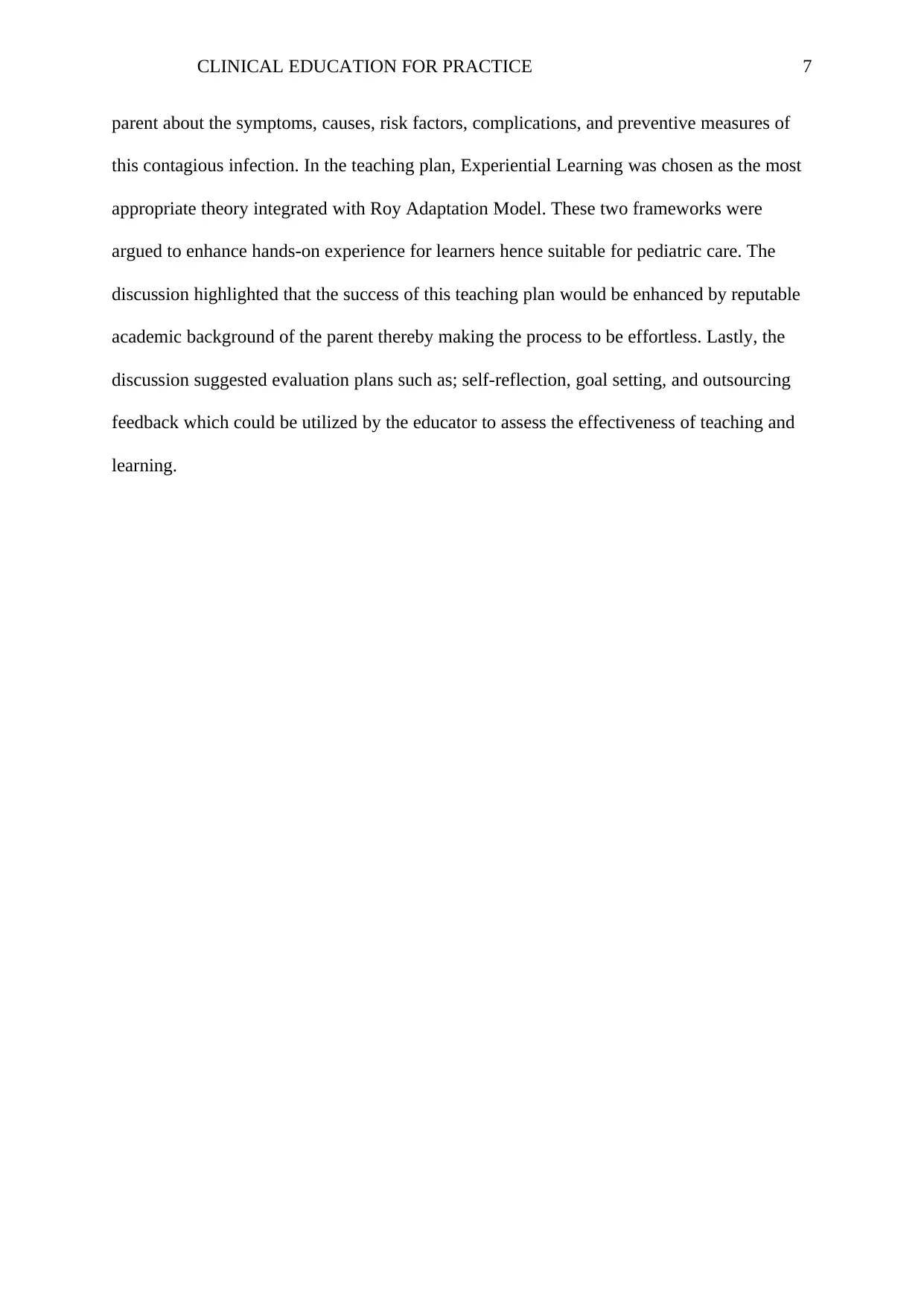
CLINICAL EDUCATION FOR PRACTICE 7
parent about the symptoms, causes, risk factors, complications, and preventive measures of
this contagious infection. In the teaching plan, Experiential Learning was chosen as the most
appropriate theory integrated with Roy Adaptation Model. These two frameworks were
argued to enhance hands-on experience for learners hence suitable for pediatric care. The
discussion highlighted that the success of this teaching plan would be enhanced by reputable
academic background of the parent thereby making the process to be effortless. Lastly, the
discussion suggested evaluation plans such as; self-reflection, goal setting, and outsourcing
feedback which could be utilized by the educator to assess the effectiveness of teaching and
learning.
parent about the symptoms, causes, risk factors, complications, and preventive measures of
this contagious infection. In the teaching plan, Experiential Learning was chosen as the most
appropriate theory integrated with Roy Adaptation Model. These two frameworks were
argued to enhance hands-on experience for learners hence suitable for pediatric care. The
discussion highlighted that the success of this teaching plan would be enhanced by reputable
academic background of the parent thereby making the process to be effortless. Lastly, the
discussion suggested evaluation plans such as; self-reflection, goal setting, and outsourcing
feedback which could be utilized by the educator to assess the effectiveness of teaching and
learning.
Paraphrase This Document
Need a fresh take? Get an instant paraphrase of this document with our AI Paraphraser
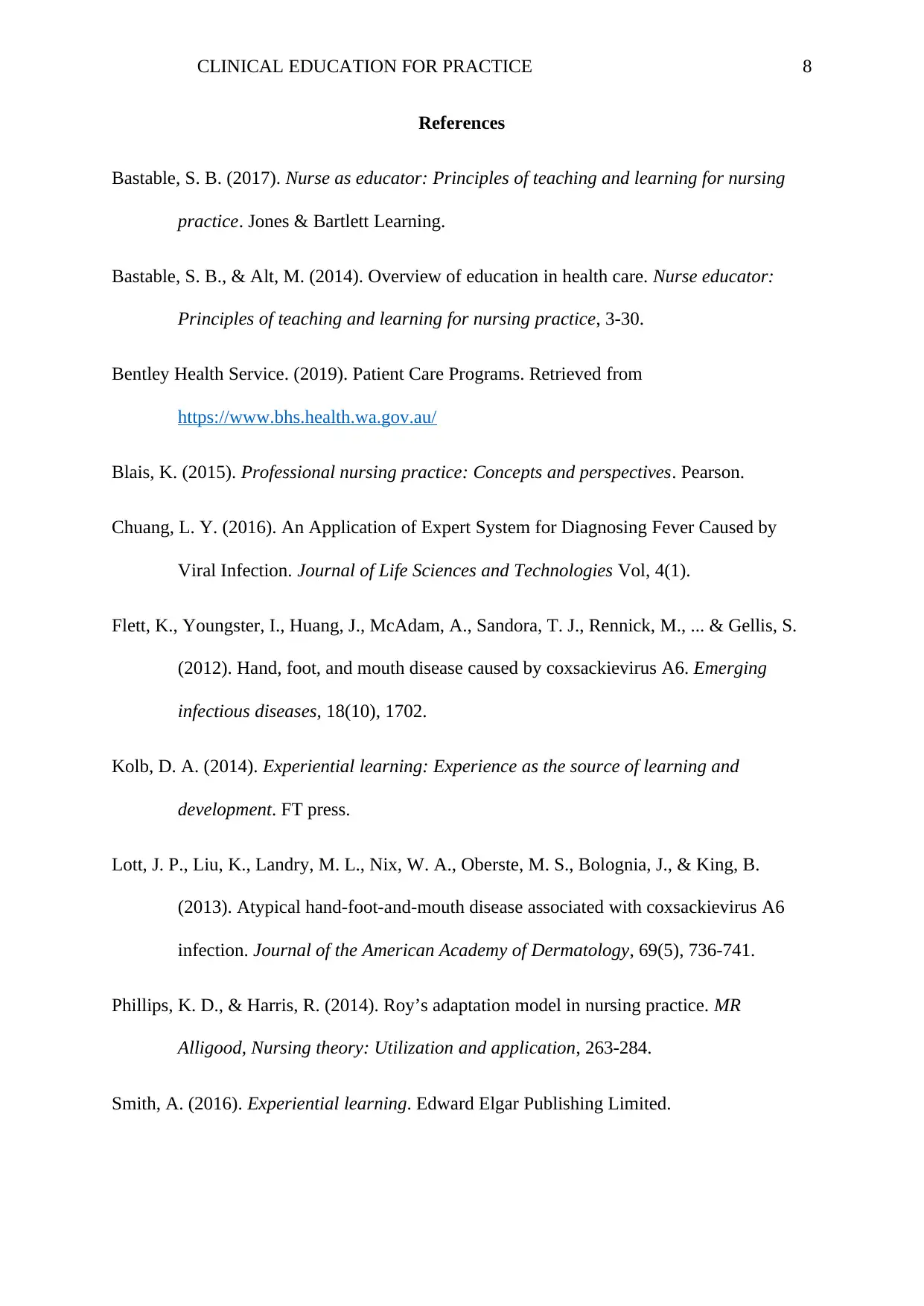
CLINICAL EDUCATION FOR PRACTICE 8
References
Bastable, S. B. (2017). Nurse as educator: Principles of teaching and learning for nursing
practice. Jones & Bartlett Learning.
Bastable, S. B., & Alt, M. (2014). Overview of education in health care. Nurse educator:
Principles of teaching and learning for nursing practice, 3-30.
Bentley Health Service. (2019). Patient Care Programs. Retrieved from
https://www.bhs.health.wa.gov.au/
Blais, K. (2015). Professional nursing practice: Concepts and perspectives. Pearson.
Chuang, L. Y. (2016). An Application of Expert System for Diagnosing Fever Caused by
Viral Infection. Journal of Life Sciences and Technologies Vol, 4(1).
Flett, K., Youngster, I., Huang, J., McAdam, A., Sandora, T. J., Rennick, M., ... & Gellis, S.
(2012). Hand, foot, and mouth disease caused by coxsackievirus A6. Emerging
infectious diseases, 18(10), 1702.
Kolb, D. A. (2014). Experiential learning: Experience as the source of learning and
development. FT press.
Lott, J. P., Liu, K., Landry, M. L., Nix, W. A., Oberste, M. S., Bolognia, J., & King, B.
(2013). Atypical hand-foot-and-mouth disease associated with coxsackievirus A6
infection. Journal of the American Academy of Dermatology, 69(5), 736-741.
Phillips, K. D., & Harris, R. (2014). Roy’s adaptation model in nursing practice. MR
Alligood, Nursing theory: Utilization and application, 263-284.
Smith, A. (2016). Experiential learning. Edward Elgar Publishing Limited.
References
Bastable, S. B. (2017). Nurse as educator: Principles of teaching and learning for nursing
practice. Jones & Bartlett Learning.
Bastable, S. B., & Alt, M. (2014). Overview of education in health care. Nurse educator:
Principles of teaching and learning for nursing practice, 3-30.
Bentley Health Service. (2019). Patient Care Programs. Retrieved from
https://www.bhs.health.wa.gov.au/
Blais, K. (2015). Professional nursing practice: Concepts and perspectives. Pearson.
Chuang, L. Y. (2016). An Application of Expert System for Diagnosing Fever Caused by
Viral Infection. Journal of Life Sciences and Technologies Vol, 4(1).
Flett, K., Youngster, I., Huang, J., McAdam, A., Sandora, T. J., Rennick, M., ... & Gellis, S.
(2012). Hand, foot, and mouth disease caused by coxsackievirus A6. Emerging
infectious diseases, 18(10), 1702.
Kolb, D. A. (2014). Experiential learning: Experience as the source of learning and
development. FT press.
Lott, J. P., Liu, K., Landry, M. L., Nix, W. A., Oberste, M. S., Bolognia, J., & King, B.
(2013). Atypical hand-foot-and-mouth disease associated with coxsackievirus A6
infection. Journal of the American Academy of Dermatology, 69(5), 736-741.
Phillips, K. D., & Harris, R. (2014). Roy’s adaptation model in nursing practice. MR
Alligood, Nursing theory: Utilization and application, 263-284.
Smith, A. (2016). Experiential learning. Edward Elgar Publishing Limited.
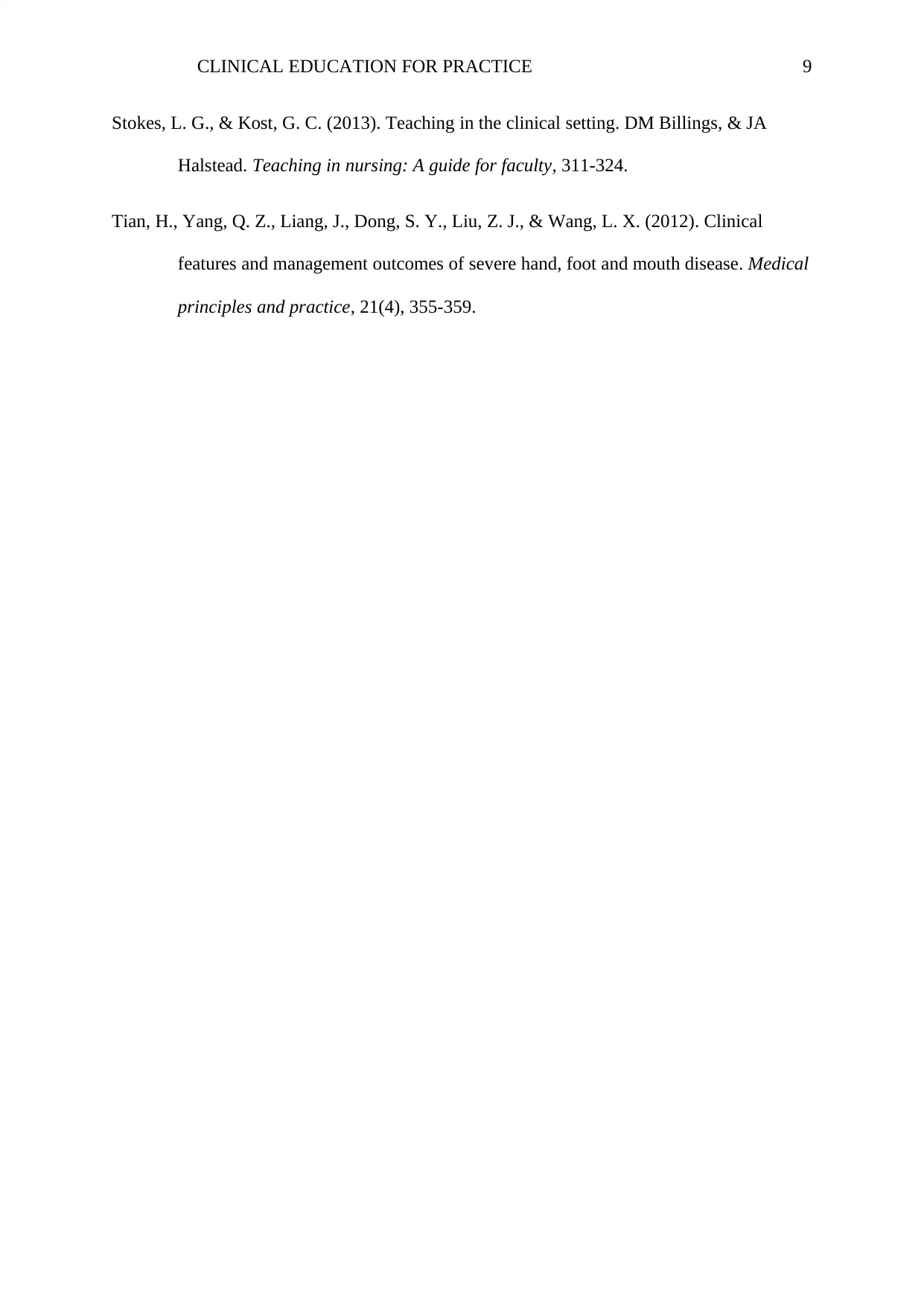
CLINICAL EDUCATION FOR PRACTICE 9
Stokes, L. G., & Kost, G. C. (2013). Teaching in the clinical setting. DM Billings, & JA
Halstead. Teaching in nursing: A guide for faculty, 311-324.
Tian, H., Yang, Q. Z., Liang, J., Dong, S. Y., Liu, Z. J., & Wang, L. X. (2012). Clinical
features and management outcomes of severe hand, foot and mouth disease. Medical
principles and practice, 21(4), 355-359.
Stokes, L. G., & Kost, G. C. (2013). Teaching in the clinical setting. DM Billings, & JA
Halstead. Teaching in nursing: A guide for faculty, 311-324.
Tian, H., Yang, Q. Z., Liang, J., Dong, S. Y., Liu, Z. J., & Wang, L. X. (2012). Clinical
features and management outcomes of severe hand, foot and mouth disease. Medical
principles and practice, 21(4), 355-359.
⊘ This is a preview!⊘
Do you want full access?
Subscribe today to unlock all pages.

Trusted by 1+ million students worldwide
1 out of 9
Related Documents
Your All-in-One AI-Powered Toolkit for Academic Success.
+13062052269
info@desklib.com
Available 24*7 on WhatsApp / Email
![[object Object]](/_next/static/media/star-bottom.7253800d.svg)
Unlock your academic potential
Copyright © 2020–2025 A2Z Services. All Rights Reserved. Developed and managed by ZUCOL.





